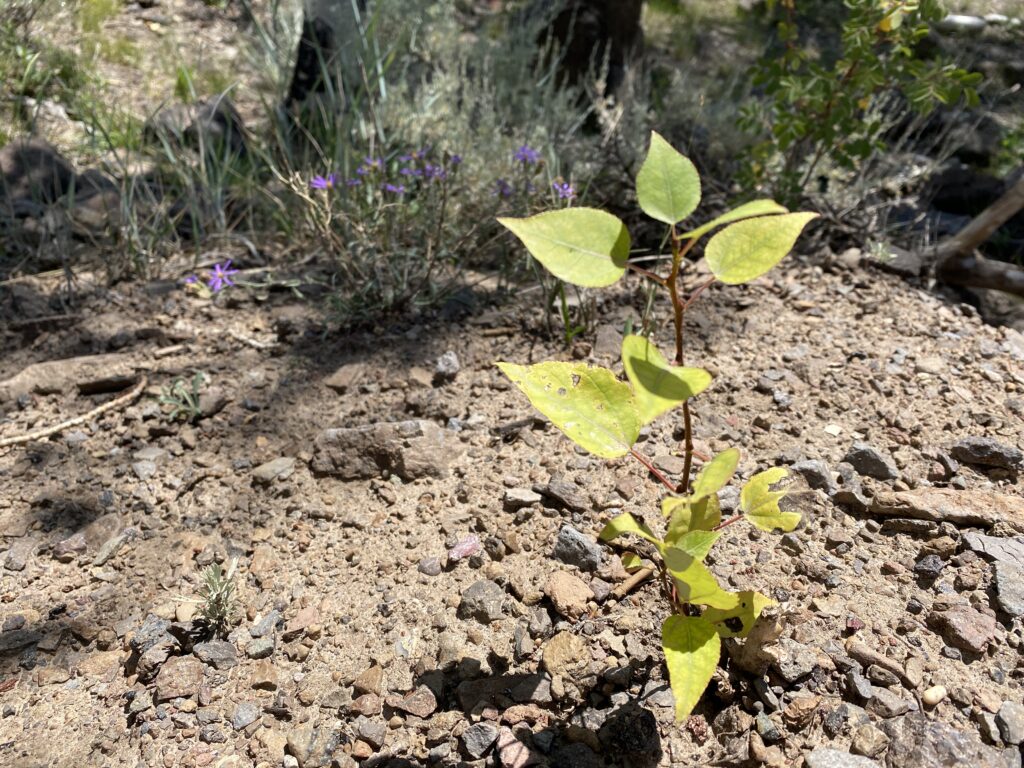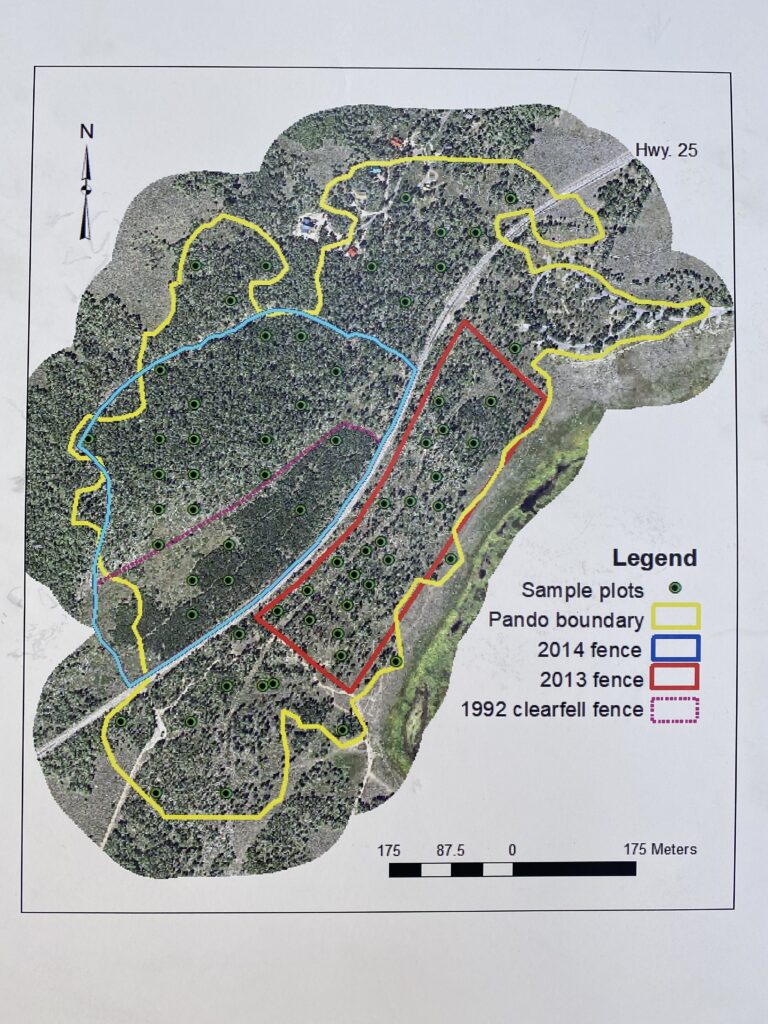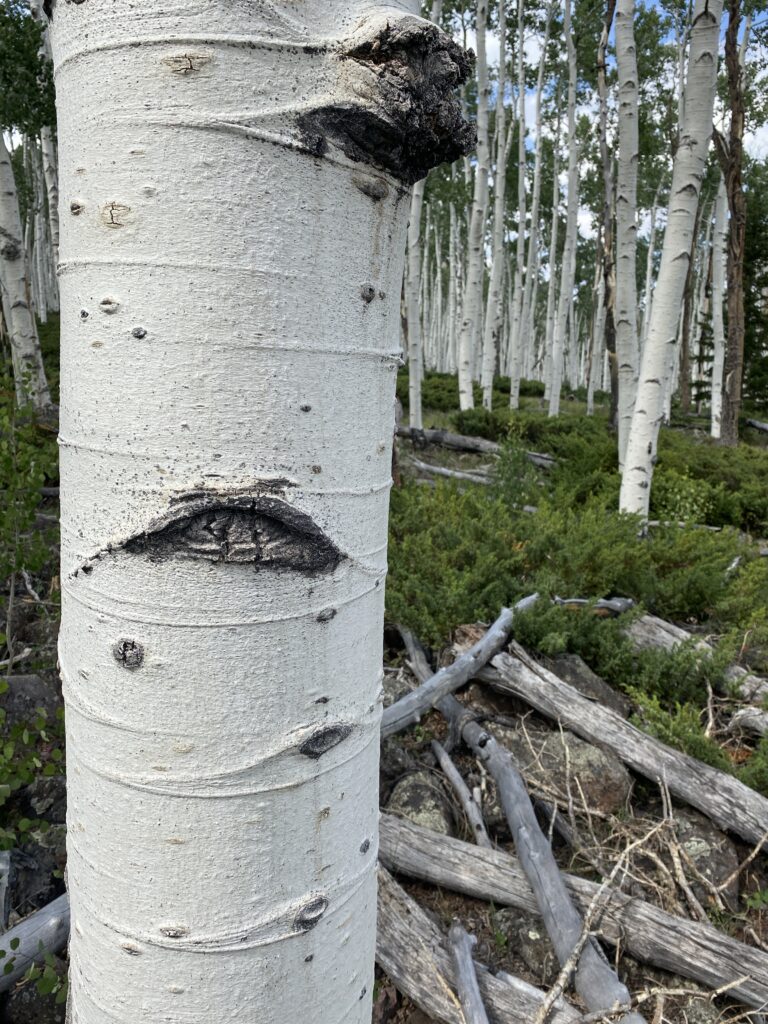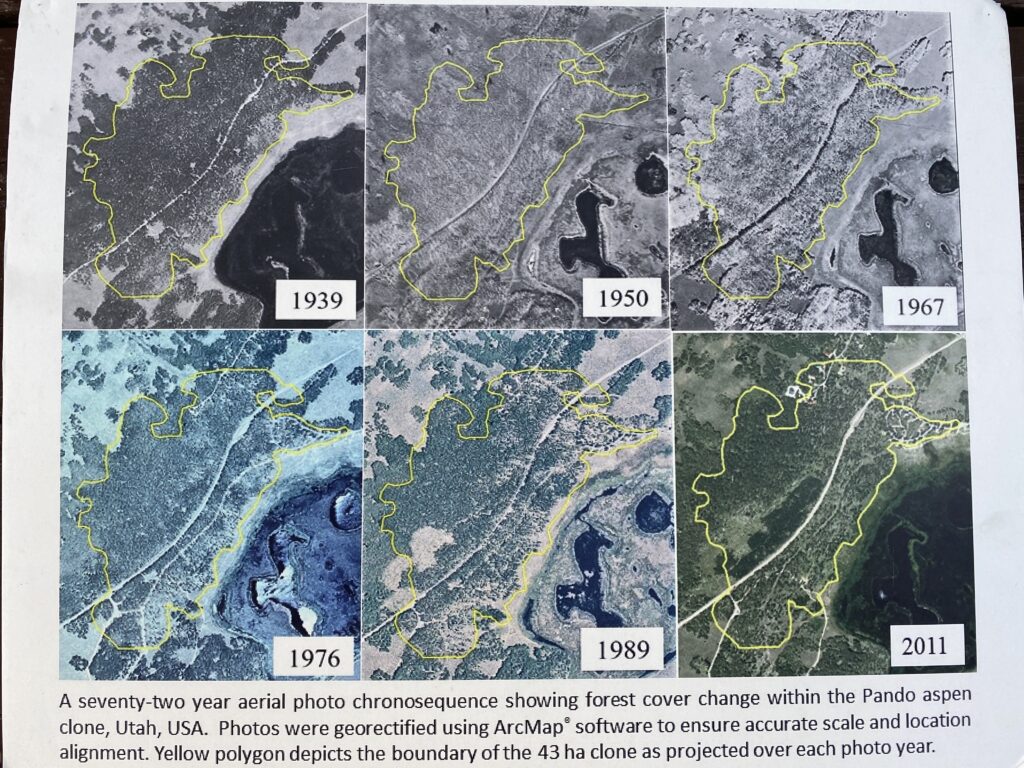ST. GEORGE — Sprawling 106 acres and composed of over 47,000 stems, the massive aspen stand known as Pando lives up to its name, which means “I spread.”

The true extent of Pando is hidden from the earthbound observer, though it can be more fully appreciated from the peaks surrounding the mountain basin of Fish Lake. In fact, “Pando” was not identified until 1976, when a research team using aerial photography and land surveying discovered that the large swath of aspen was actually a single organism.
Now, volunteers with the Friends of Pando organization are conducting a photographic survey of the interior of Pando, with most of the photography completed in the timeframe between July 31 up to Sunday.
The end goal: to create a full-color, 360-degree photo gallery documenting all of the giant aspen.
“We’re doing something that’s never been done before,” said Lance Oditt, lead photographer for the survey. “We’re trying to capture 8,600 locations in nine days, and then we’re going to publish this and put it online. We hope that scientists can study it (Pando) remotely, so we can better understand the tree.”

Oditt said the work that remains after Sunday includes careful survey of the more treacherous parts of Pando’s territory, which he plans to complete himself as the bulk of the photos are being processed.
The monumental project gathered contributors from all over the United States as well as locals, including Tiesha Smith – a Sigurd, Utah, native who spent much of her life working and playing in Fishlake National Forest.
“I had no idea this (Pando) was a thing,” Smith said. “I’m 19 years old; I’ve lived in this valley my whole life and I didn’t know any part of it. And I’m so glad I get to be a part of something bigger to educate and inform.”
In addition to creating a scientific record, the images gathered will be made available to educators and members of the public to raise awareness of the titanic tree. Oditt said he plans to combine the photos with a documentary film to create a virtual reality experience where people can explore Pando without ever leaving their own neighborhoods.
Photo survey
During the nine-day survey, the volunteers planned to document about 90 acres of Pando using 360-degree cameras and geolocation data. The end result would be around 16-20 terabytes of photos, each geotagged to record its precise location.

The perimeter of Pando was surveyed to mark its boundary and to plot routes for the photographers to complete. Routes were assigned in twice-daily team meetings, after which the volunteers would hike to the marker flags at the beginning of their routes.
Once they arrived at the beginning of their route, each photographer would take note of their progress on the route, verify the exact coordinates using a handheld GPS, clean the camera and then take the photo – doing their best to move out of the camera’s vicinity and hide behind tree trunks or rocks to avoid being caught in the photo.
The photographer would then return to the camera stand, orient themselves along the east-west line of their route, pace out 7 meters in as straight a line as possible to the next photo location and start the process over again. The sign of success was emerging on the other side of Pando directly opposite the starting marker.
“It’s rewarding when you go through a line and come out in the right place and you know that you’ve recorded that portion of the tree,” said J. Brunner, a senior photographer for the survey. “It’s making history: it’s not just taking a picture of what we think to be the largest tree and heaviest organism. This is a historical record that’s going to benefit everybody.”
Brunner joined a team of 24 citizen scientists, ranging in age from 13-69, acting as photographers or support volunteers. Although he had prior experience with advanced photography techniques, Brunner said many of the participants were using the high-tech 360-degree cameras for the first time.
The photographic expedition faced challenges from the start. Rainy weather and faulty cameras slowed the survey’s early progress, and volunteers had to adjust to the taxing work of spending seven hours a day moving photography equipment through the dense brush and rocky terrain that prevails through Pando’s footprint.

By the end of day six, a growing frustration with the abundant juniper bushes that would trip or scratch the photographers had the volunteers considering rebranding as an “anti-juniper society.”
“Before I thought they were nice and pretty and smelled nice, but there are so many that you have to walk through that. I’m starting to get very annoyed with the juniper,” said Kyden Saner, a student-volunteer from Snow College. “As soon as this project is done I’m sure I’ll be able to appreciate it again when I’m not tromping through it.”
Collaboration was key to improving the process each day. Several of the volunteers spoke about the learning curve they experienced, and many reported feeling much more confident and proficient midway through the project.
Janis Connell, a fine-art photographer based out of Durango, Colorado, was another senior photographer on the survey. She said she was challenged by the physical and technical demands of the project, but she found fulfillment in improving her technique and becoming more productive each day.
“The work that we’re doing – and it is work for sure – is very empowering,” Connell said. “It can be frustrating at times because you’ve got to learn how to use a compass and GPS, and half the time I feel like I’m not on my line. But I feel like we’re doing something historic and monumental, and I hope the tree gets the attention and the reverence that it deserves.”
Friends of Pando
Officially organized in 2019, Friends of Pando is a not-for-profit, all-volunteer organization. While there is no formal membership or board of directors, those who count themselves as “friends” are united by a shared love of Pando and a desire to raise awareness about the extraordinary tree.

With the motto “any friend of Pando is a friend of mine,” it’s appropriate that the organization grew out of a friendship that turned into a collaboration between Oditt and Paul Rogers, an associate professor at Utah State University.
Oditt, who owns a fine-art photography and documentary studio in Seattle, Washington, was undergoing treatment for a chronic form of blood cancer in 2016, when he rediscovered his love of nature photography.
“I looked at my archives, and I realized I’d always been photographing trees, which surprised me,” he said. “I started to focus on trees and forest conservation, and long story short, I went on this road trip I called ‘Tree of Life.’ I went to Redwoods, Sequoia and Joshua Tree (national parks). I did some photography work with white bark pine, limber pine and bristle cone. And I came out to Pando.”
In his visit to Pando, Oditt learned about the Western Aspen Alliance, a research organization directed by Rogers. The two started talking about ways to bridge the gap between science and art, using their unique expertise in each field to champion Pando and share it with the world.
In preparation for the photographic survey, Oditt and other friends of Pando, including Associate Professor Ryan Thalman of Snow College, began reaching out to college students at campuses across the country.

News of the survey got as far as the campus of the State University of New York at Fredonia, where Wilson Thorpe and Ngawang Salaka are currently enrolled.
“Lance (Oditt) gave a virtual seminar to our class; and from there, we got connected,” Salaka said. “The title of our class was ‘graphic design,’ and there’s a lot of things that design can help with at pando, including accessibility.”
After first hearing about it in the spring of 2020, Thorpe and Salaka ultimately decided to volunteer for the survey and drive thousands of miles cross country to participate. Both men are natives of New York state, and had never been to the Intermountain West before this trip.
“It’s been very surreal,” Thorpe said. “I’ve never really seen a forest like this, and then knowing what Pando is – it’s kind of mind-blowing. I really love it out here. I’ll be sad to go home, but I’m excited to bring the news back about what we’ve been doing and share it with everyone where I’m from.”
The outreach from Oditt and Thalman also caught the attention of in-state students, attracting volunteers from BYU, Snow College, UVU and even nearby high schools. In his natural resources class on the Richfield campus of Snow College (less than an hours drive from Pando), Thalman encouraged his students, including Saner, to participate in the survey.

“Aspens have always been my favorite trees – they’re just so unique in every way,” Saner said. “I also enjoy being outside and hiking. Part of the reason we’re getting all these photos is so people who can’t come through and do all this (hiking) are going to be able to virtually do it.”
As Saner and Thalman explained, one of the goals for the photo survey was to create a resource for anyone, regardless of location or physical ability, to explore Pando and experience the gigantic tree for themselves. Accessibility and scientific value were the highest priorities of the photo survey, Thalman said.
To view a sample image demonstrating the concept behind the photo survey, visit the Friends of Pando website. More information about the volunteers who conducted the photo survey and updates on its results will be posted there as well as plans for future projects involving Utah’s golden giant, Pando.
Click on photo to enlarge it, then use your left-right arrow keys to cycle through the gallery.
A 360 image of the entire photographic survey team, seen here projected as a flat photo, Fish Lake, Utah, date unspecified | Photo courtesy of Lance Oditt, St. George News Senior Photographer J. Brunner takes careful notes of his location and progress while completing one of the survey's routes, Fish Lake, Utah, Aug. 5, 2021 | Photo by Ammon Teare, St. George News A young aspen stem brings new growth to Pando, Fish Lake, Utah, Aug. 5, 2021 | Photo by Ammon Teare, St. George News Wilson Thorpe, pictured here cleaning one of the lens of the 360 camera, traveled thousands of miles from his native New York to help with the survey, Fishlake, Utah, Aug. 5, 2021 | Photo by Ammon Teare, St. George News Ngawang Salaka cuts a trail through the difficult terrain of Pando's northwest growth. Salaka accompanied his classmate and friend, Wilson Thorpe, on a cross-country roadtrip to survey Pando, Fish Lake, Utah, Aug. 5, 2021 | Photo by Ammon Teare, St. George News Two mature stems of Pando tower over a large swath of young growth, Fish Lake, Utah, Aug. 5, 2021 | Photo by Ammon Teare, St. George News A map showing the extent of Pando as well as recent fencing installations to protect its growth | Image courtesy of Paul Rogers and Darren McAvoy, St. George News One of Pando's stems bearing the characteristic "aspen eyes" from old branch scars, Fish Lake, Utah, Aug. 5, 2021 | Photo by Ammon Teare, St. George News Aerial survey's throughout the 20th and early 21st century show Pando's growth as well as human impacts on it's sprawl, | Image courtesy of Paul Rogers and Darren McAvoy, St. George News








Copyright St. George News, SaintGeorgeUtah.com LLC, 2021, all rights reserved.

